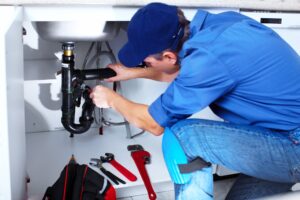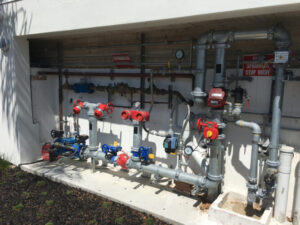Plumbers install and repair pipes, fixtures, and appliances that deliver water and remove waste in homes and businesses. They read blueprints and building codes to determine the layout of pipe networks and connect them to fixtures such as sinks, toilets, and showers.
Plumbing can be a rewarding career for those with the right mix of education and experience. Many plumbers start their careers after completing a vocational school program or a learn-while-you-earn apprenticeship. Contact Hubbard Mechanical now!

Plumbing is a trade that encompasses a wide range of skills and tasks. Plumbers install and repair pipes, valves, fixtures, and appliances that carry potable water or remove waste in residential and commercial buildings. They also use specialized tools to inspect and diagnose problems with plumbing systems.
Pipes are the conduits that carry water, waste, and steam throughout a building. They are usually made from metal or plastic, although in the past, wood and lead (the Latin plumbum) were used. Today, most piping is done with copper, steel, galvanized steel, or plastic. Metal piping is typically joined using soldering, brazing, welding, or threading, while other materials may be joined by crimping, compression fitting, or solvent welding.
Valves are the devices that control the flow of water through a system. They are normally located at the points where water enters and leaves a building, including toilets, faucets, showers, hot water heaters, and washing machines. Other valves are found in steam traps, backflow preventers, expansion tanks, and pressure gauges.
Fixtures are the devices that are attached to pipes, such as sinks, toilets, bathtubs, showers, and faucets. They can be installed either permanently or temporarily and are typically referred to as “hardware”. Plumbing fixtures are often designed to be as durable and attractive as possible while still being functional and easy to maintain.
Appliances are the mechanisms that are used to heat, cook, and clean. They are usually powered by gas or electricity, and include dishwashers, washers, dryers, ovens, refrigerators, and furnaces. Plumbing systems are often connected to these devices via venting, drains, and ductwork.
Commercial plumbing involves the installation and maintenance of large-scale water supply and wastewater removal systems in buildings such as office complexes, hospitals, factories, and warehouses. Plumbers in this field must be familiar with the special requirements of each building’s occupants and design the system accordingly.
In addition, plumbing in these buildings must be compatible with the building’s heating, ventilation, and air conditioning system. In most cases, these systems must be able to handle high volumes of water and waste without causing leaks or clogs.
Pipefitters are highly skilled tradespeople who work on high-pressure systems in commercial and industrial projects. They use carbon steel, stainless steel and many metal alloys that are essential for a wide range of complex and sensitive facilities, including hospitals, power plants, pharmaceutical companies and more.
They assemble, install and maintain these heavy-duty pipes in live buildings, so they must be able to work quickly and accurately while juggling multiple tasks. This includes reading blueprints and using hand and power tools to cut, weld, braze, solder and cement joints. They also perform system inspections and tests and ensure that the pipes meet building standards and plumbing codes.
The pipes they work with are used for cooling, fuel transport, heating, scorching water, hydraulics and steam. They must understand how each of these functions and be able to shape the correct metals to fit that industrial use. This means that a pipefitter’s daily workload varies from project to project, depending on the needs of each facility.
A pipefitter must be familiar with a variety of piping couplings and systems, including grooved, threaded, socket welded and Victaulic. They must also be able to read and interpret plans in three-dimensional terms and have excellent problem-solving skills to resolve issues.
In addition to their technical knowledge, they must be able to communicate with engineers, construction workers and other personnel on a daily basis. This requires strong verbal and written communication skills. Additionally, they must be able to juggle several tasks at once and be able to adjust on the fly when things go wrong.
To start a career as a pipefitter, you need a high school diploma and specialized training courses that include math and science. Most pipefitters get their training from a vocational school or an apprenticeship program. Some colleges offer associate degrees with a pipefitting concentration for those who want to pursue this craft further. They must also pass a rigorous test called the turn-out exam to become licensed journeymen. This is a demanding career, but it can be very rewarding for those who are dedicated to the craft and are eager to keep learning.
Force mains, sometimes referred to as rising mains, are pipes fitted with pumps to lift wastewater from lower-elevation areas where gravity is not sufficient for conveyance of the sewage. They are used where sanitary sewer lines connect buildings located in low-lying sloped areas to municipal sewers that run to a treatment plant at an elevated elevation.
Due to their high consequence of failure, force mains require the most intensive maintenance of all sewer pipelines. Fortunately, today it is easier and more cost-effective than ever to assess the condition of your force mains without impacting daily operations. This allows utilities to collect actionable data that empowers proactive pipeline management – getting ahead of costly failures, planning short-term repairs, and taking a strategic approach to long-term capital planning.
While force mains make up a small portion of the total network of wastewater pipelines, they can have a significant impact on the overall collection system performance when they fail. They are critical in transporting waste from residential and commercial customers to the centralized wastewater treatment plant. They also connect sewer systems to other basins and are vital to the proper operation of a city’s entire water and sewage infrastructure.
Like the majority of sewer pipes, sewer force mains are designed to withstand corrosion and handle high volumes of corrosive wastewater. They typically feature iron pipe with concrete lining or thermoplastic (polyvinyl chloride [PVC], acrylonitrile-butadiene-styrene [ABS], or polyethylene) piping, which offer greater inside diameters and tighter joints.
Because of their location underground, access to force mains is limited. Unlike gravity flow sewers, which are accessible by manholes at regular intervals throughout the system, many of these pipelines are only accessible via a series of lift stations along the route. This makes the inspection and repair of these pipelines more challenging than the more commonly accessed gravity sewers.
Traditionally, when existing force mains needed attention, it was necessary to dig up the pipeline for rehabilitation. This type of construction is time consuming, expensive, and disruptive. However, as trenchless technology continues to evolve, these tools are increasingly being applied to the rehab of sewer force mains. Whether through internal visual inspection, flow or pressure testing, or other suitable means, these technologies can provide valuable information that is not possible to gain with traditional inspection methods.
Despite their surface-level resemblance, plumbing and piping systems have very different purposes. The most significant difference is that plumbing systems are used to transport potable water and wastewater, while piping systems handle chemicals, gases, water, and other fluids that support internal manufacturing processes. These differences can be distinguished by looking at where the pipes connect, what they’re carrying, and the rules and regulations that govern each type of system.
Pipes and their in-line components like fittings are made of materials including wood, glass, fiberglass, steel, aluminum, plastic, or copper. They are usually joined together using fasteners, such as a stud bolt with nuts, or joints, like elbows, tees, and couplings. Fittings are also used to make connections between pipes at different points, as well as to other components such as valves, which can be turned on or off to allow or stop the flow of liquid.
The piping system may also contain a variety of in-line components that are used to sense or control the pressure, temperature, and flow rate of liquid. This can include sensors, flow meters, and gauges which monitor and measure a specific parameter. Valves are devices which can be turned on or off to allow and stop the flow of liquid or gas. Piping systems are often categorized by the function they serve, rather than the materials used, and these classifications can be very distinct.
For example, a one pipe plumbing system is designed to supply all fixtures with hot and cold water, while a two pipe plumbing system supplies some fixtures with hot and others with cold water. This type of piping system also differs from process piping, which is often designed to convey chemicals, gases, water, and other fluids, sometimes under pressure and at high temperatures, for the purpose of converting raw materials into finished products.




